RED LIONS

I had arranged to meet the Fishing Magic and Thomas Turner teams at the Red Lion in Bredwardine on Wye, which is not far from Hereford. I was surprised seeing another Red Lion on the way, but when I arrived at the correct one, the landlord explained it’s the most used name for hostelries in the U.K. His was called a hotel and it’s a popular place where many anglers traditionally stay when visiting the fabulous river. It looked more like my idea of the perfect pub – with lots of extra rooms attached. I was told it would be all fishing talk in the bar and restaurant that evening, but for me it started the minute I arrived, meeting up with John Bailey again after many years. I fished with JB in Norfolk a few times, but now he had moved to this wonderful neck of the woods, I was intrigued to explore his favourite new river. John had barbel firmly in his thoughts, while for me if I get the chance to use a stick float, I don’t mind what turns up.
TOP RIVERS

We went to one of the nearby Red Lion beats first. The hotel runs 8 miles of fishing on the Wye and if this spot was anything to go by, I would be booking my next holiday here. The meandering river and rolling countryside were stunning. John put me on a long gravelly glide and for the first 15 minutes I just sat there, feeding hemp and casters, watching the world go by. Over the years I have learnt on rivers not to dive in with a baited hook too quickly. Far better to get fish feeding confidently before running a float through, or casting a leger rig over any type of loose feed. The Wye Valley reminded me of the similarly wild River Vyrnwy in Wales, which I once stumbled on by accident. I had spotted a sign at the entrance to a farm, saying it was a fiver to fish their stretch of river. It was money well spent because I caught chub all day long. When I eventually got fishing on this occasion, it wasn’t long before chub turned up here too.
TESTING TIMES

On any swim with decent flow, I can’t resist having a go with a stick float, a method I first learnt properly when I used to do weekly features for Angler’s Mail. I was privileged to fish with many top rods, travelling all over the country. Watching superstars like Frank Barlow, John Warren and Keith Arthur, expertly running sticks down their favourite rivers, left a big impression on me. Now I live close to the River Trent and Upper Witham, this great method gets used a lot more. I still use a prototype 13ft float rod I was developing for Hardy, as a follow-on from the now famous Marksmans. This was made from even more advanced carbons and has proved to be something very special. Sadly, Pure Fishing did away with the coarse section of Hardy and the new rod range I was developing never happened. It’s finally going to happen with Thomas Turner, but first rods needed testing. This is a trusty prototype bent into a powerful fish.
OLD & NEW
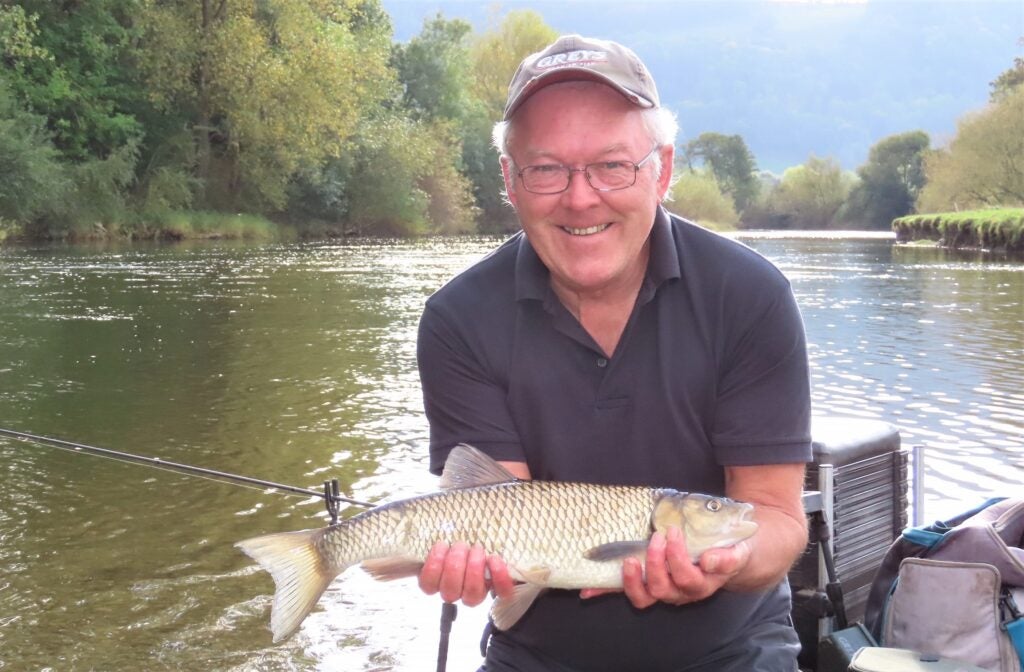
I had decided to initially use a rod I was familiar with before diving in with a new sample, to remind myself what was needed before field-testing a blank employing even more advanced and ultra-modern nano carbons. I had not yet seen anything to beat my original 13ft prototype, which covers most of my stillwater waggler and river float fishing requirements. I’ve never fished the Wye before and in a way, it seemed right to bring an old favourite into play first. It’s landed some cracking big chub on light lines and small hooks, having the ability to fully absorb the lunges of big fish, while still retaining excellent control. It was doing its job perfectly all over again. The session started by working through a shoal of dace. A two-pound chub put in an appearance next, followed by a duo of crazy wild trout, which tried all sorts of acrobatics to shed my tiny size 18 hook. They failed and then the chub got bigger. Some proper rod-bending action followed.
GREAT COMBO

Bringing the new 13ft float rod out of its plush Cordura tube revealed a subtle, somewhat traditional looking slim green blank, to which gold tippets had been added to the whippings. This gave a small hint that this was going to be a special range of rods. I set up with one of the stick floats I designed for Angling Direct, a model with a heavy cane stem and hollow plastic tip. The latter idea came from pole floats with similar translucent sight tips that show up better. These new style sticks certainly do that, staying highly visible down some of the longest glides I’ve had the pleasure to fish. It was an absolute joy running a float rig through yet another Wye swim JB put me on the following day. This time I was plagued by minnows and small dace, only managing one good chub in the first couple of hours. The new rod dealt with it superbly, using similar light tackle to the day before. I fed even more heavily, but in the end the small stuff just got busier.
LEARNING CURVE

When John joined me, he fished close by because he was going to test out an 11ft Avon sample and I wanted to see how it behaved. He heaved out a load of boilies and within minutes his rod was bent into something wild and powerful. I don’t know if JB was talking to himself or to me, but it was good that he was absolutely purring about the new rod. While this was going on, I put aside my float tackle and replaced it with a two-piece 12ft quivertip set-up. I noticed John was touch legering with a rolling leger, unusually incorporating several spread-out SSG shot. While a good chub was being netted, I brought into play a pellet feeder. I doubt many anglers use these on the Wye, but as regular readers will know, it’s a method that has caught my attention. I had only used it on stillwaters previously, but could see no reason why it shouldn’t work in running water. The first take was savage, a thump that was transmitted down the whole blank.
CHUB CITY

The heavy resistance I had hooked into immediately went solid on me. I tried everything from changing rod angles to slack lining, but couldn’t move it. I suspected the hook had been transferred into an unseen snag and when I pulled for a break the tackle came free. Meanwhile, it was all action on John’s Avon, with yet another cracking fish giving it a thorough workout. I was so busy watching all this, I completely missed a second savage pull with a banded 6mm pellet on my feeder rig. I gave up on that for a while to enjoy all the action. The prototype Avon was looking the business as JB expertly played in another big chub. I noticed these fish fight differently when attached to stiffer action rods. They really get upset and boil up the surface as they near the landing net stage, making frantic lunges towards the bank in a last-ditch attempt to find snags. The battle is nowhere near the same when similar fish are hooked with softer and longer float rods.
DIFFERENT WORLDS
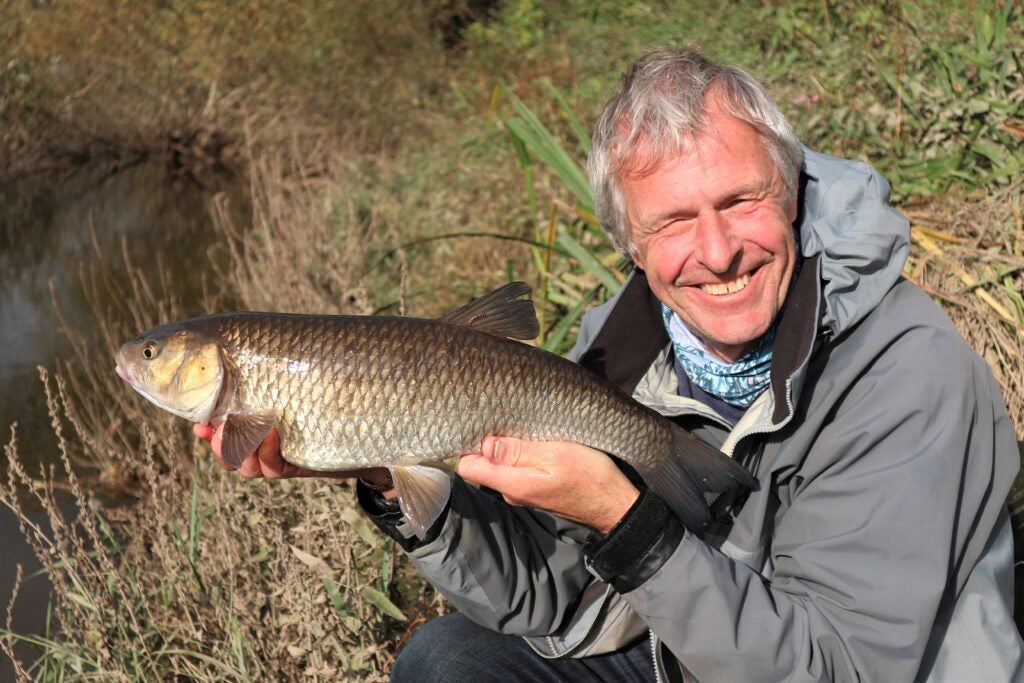
Another beautiful Wye chub for JB. A similar fish I caught earlier on my 13ft float rod had bolted out into the main current, but after that, with the whole rod absorbing all the force, I had managed to coax it in with less disturbance. If you get the pressure just right, it’s a bit like walking a dog on a lead. Pull hard and fish tend to pull back, but direct them more gently and they follow much more tamely. I learnt that trick when catching big river bream over in Ireland. Hit them like a brick wall with a stiff rod and they would get sideways on in the current and take ages to pull in. But lift into them gently with a softer-action quivertip blank and they could be cranked in by both the rod and the reel, with much less fuss. But having said that, I’m not really targeting double-figure barbel and specimen chub like the evergreen Mr Bailey. These fish are probably small fry to him, but absolutely massive from a seasoned match angler’s point of view.
DIFFERENT GEAR
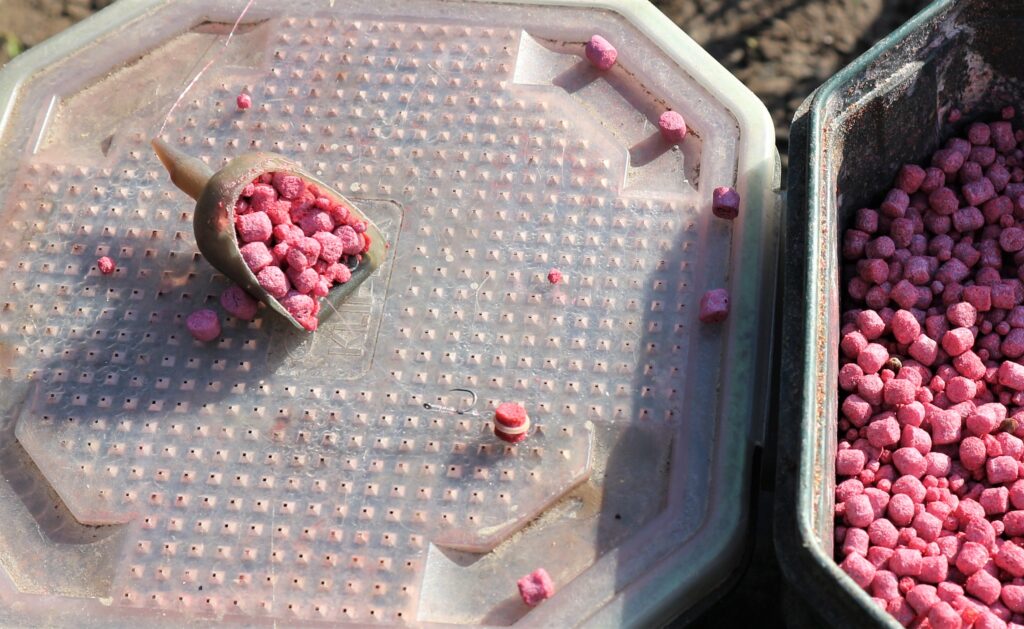
John looked a bit gobsmacked when he saw the strange feeder rig and pink coloured, meaty-flavoured pellets I was using. He didn’t comment, probably thinking to himself these match types are bonkers! But I did spot a similarity in the way we fish. He was using spread-out shot with his touch leger rig. Four spaced SSGs, that sounded like boilies hitting the surface when they went in. Also, cleverly, the spread weights were gripping bottom out in the flow, just as well as a much heavier bomb or feeder would. This meant they were critically balanced, so anything touching the hook bait caused pronounced drop-backs as the tackle lost its grip and moved. I use spaced shot a lot too, instead of big bulks, in my case with deeper pole rigs. This also gives a different type of presentation, making the hook bait behave more naturally and picking up any underwater tow. We live in different worlds, but both obviously think hard about what we are doing.
THE ‘B’ WORD

JB previously mentioned when talking about our sessions on the Wye that he didn’t think I fed enough to catch barbel. I’m pretty sure he’s correct, but it’s just not in my DNA to hit swims hard with lots of grub. So many years of match fishing and trying to coax poor pegs into life, have made me feel my way into sessions, rather than trying to gatecrash them. It’s the old match mantra; you can’t take out what you put in. But having said that, now I was seeing what makes the Wye fish respond, I could easily change tactics if I return to this wonderful place. It’s been too many years since I used to target barbel on the River Thames, a lifetime ago really. Back then I would think nothing of dumping a gallon of hemp in to get through small fish and find some whiskers. These days it’s more about boilies and pellets. That Avon rod was arched over again, only this time it was a very different battle. A big dorsal fin was cutting through the surface.
FAIR PLAY
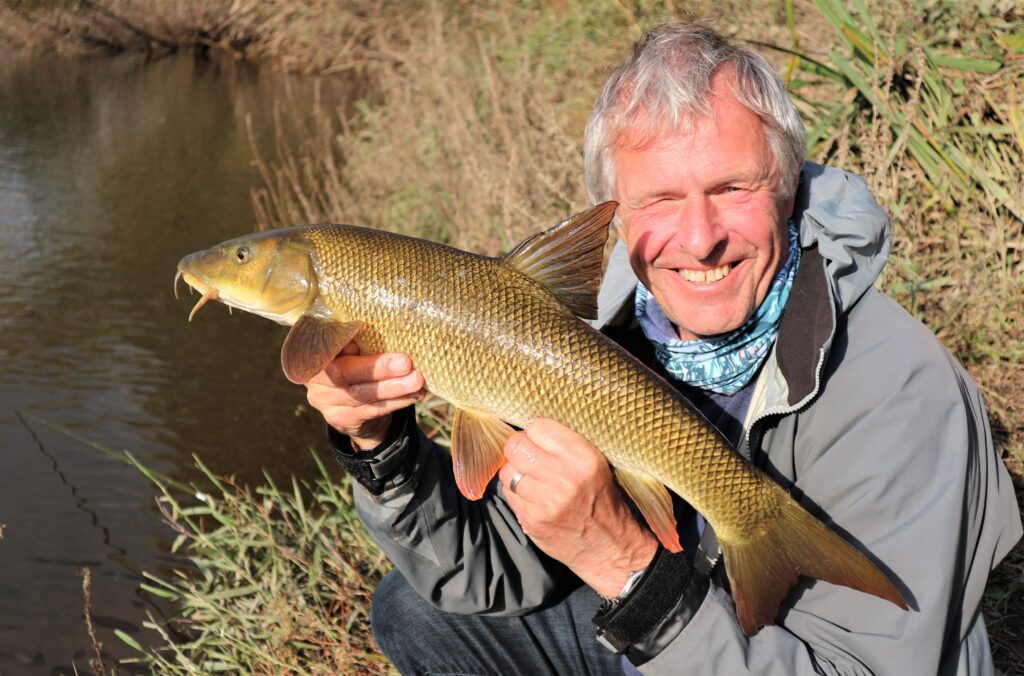
I had forgotten how beautiful river barbel are, but was soon reminded when JB proudly held up this prime example. I’ve been side-tracked since moving to the Midlands, fascinated by big chub. Going back to when I fished for them on canals around London, a three-pounder was a huge fish. Nowadays on rivers like the Trent and Witham four-pounders are common, with fives and sixes also turning up. This has opened up a new world for me, which has grabbed much of my attention, along with catching specimen-sized roach. But now, seeing this wonderful barbel, I really need to have a rethink. I can understand why most anglers I see on the tidal Trent these days now use light specimen rods, set pointing skywards on pods. I might not take that route, but using more bait is an option, along with possibly some bigger feeders and chunkier river floats. Back to the present, and after this fish JB departed to meet some friends on another stretch.
WORKING UP
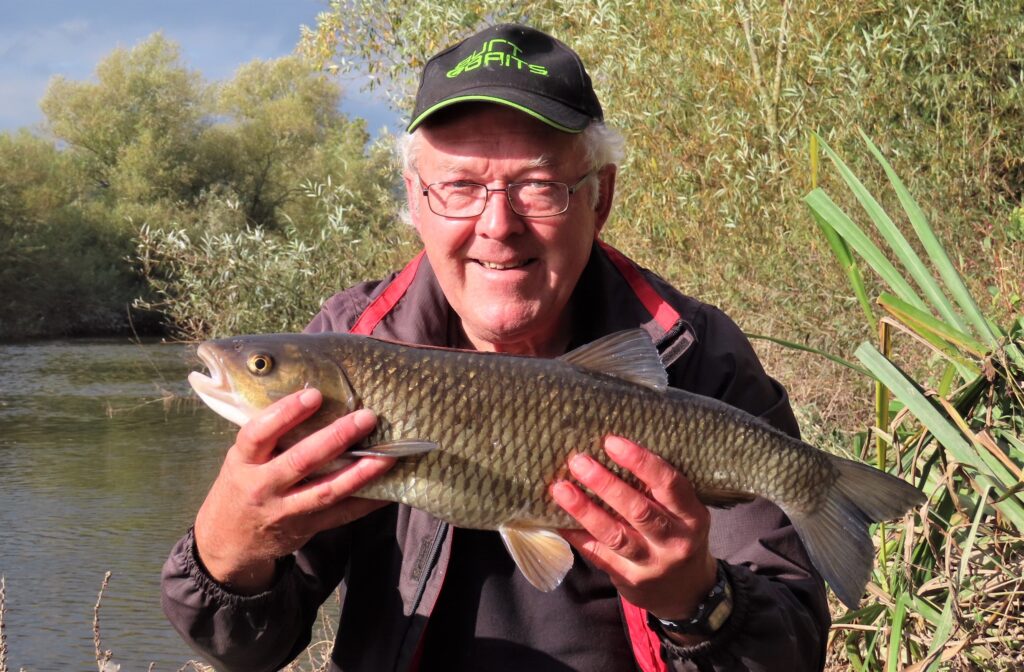
I had noticed John was feeding and casting upstream. It worked wonders for him, so I tried a cast up into the hotspot. My pellet feeder had only just settled before my 2oz quivertip dropped back violently and suddenly a good fish was on. It thumped around alarmingly on my new feeder rod sample, but everything held okay. I soon had this nice chub in my landing net. The upstream swim had been hit with Scopex flavoured boilies and now it was getting Polony pellets. The chub didn’t seem to mind because I caught an even bigger one after this. Just as I was dreaming barbel, another pronounced drop-back resulted in more severe rod bending, only this time the fish inexplicably came off. The action ended after that, but I wasn’t disappointed. It had been fabulous, ticking off yet another great river on my venue list. I can now understand why so many anglers rate the Wye as the best in the country; it’s an amazing place and brimming with fish.


